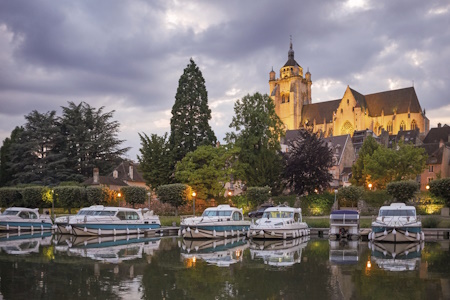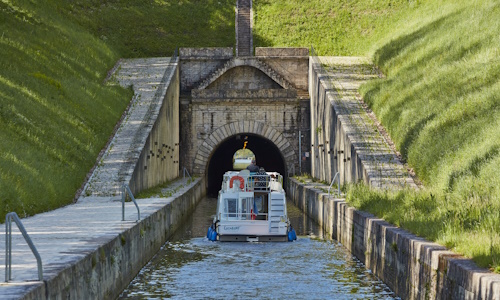Franche-Comté is crossed by:
- The Doubs, also known as the Rhône-Rhine Canal.
A small wild river, the Doubs was canalized to make it navigable. It crosses a green valley. Everything is soft and peaceful here. You will encounter many Montbéliarde cows (red and white) that produce Comté, Morbier, Mont d'Or, Bleu du Jura...
- The Petite Saône
This magnificent calm and green river flows, among others, in Haute Saône, a rural department far from the hustle and bustle of big cities, a deep France that really deserves to be discovered if you want to recharge in the true countryside.
Hesitating between the Petite Saône and the Rhône-Rhine Canal? We explain the differences between river and canal navigation.
Franche-Comté is part of the Burgundy Franche-Comté destination that we offer for your next river cruise.
Franche-Comté gives access to the Saône Valley and the Burgundy canals, two basins open to river tourism where we also offer a wide range of license-free habitable boats, barges or Pénichette®.
And if you are wondering how to choose your boat, check out our advice page.
Must-sees in Franche-Comté by Boat
- Cancoillotte, Comté, Mont d'Or, Morbier, these cheese names are not unknown to you.
You can enjoy them without moderation during your river cruise in Franche-Comté and of course accompany them with the famous Jura wines.
- Arrive in Besançon with your boat via the Doubs, circle the city and close the loop of the meander thanks to the tunnel dug under the hill. Moor your boat at the Saint Paul port and climb to the Vauban citadel, a UNESCO World Heritage site. Then take the time to stroll through the streets of this city labeled City of Art and History and capital of Franche-Comté.
- Dole, a major river port in France. You can soak up the life of the boatmen. Try a pochouse (river fish bouillabaisse).

Some stops on your cruise in Franche-Comté
The Petite Saône
192 km of navigable waterways - 20 locks Commonly called: "Petite Saône" from Corre to St Symphorien sur Saône near St Jean de Losne.
Corre. This village is rich in a precious past. Corre already existed in the Gallo-Roman era, as evidenced by the large number of discovered remains. The locality is active but calm, and the surrounding walks are varied.
Port Sur Saône. A Gallo-Roman agglomeration, it gave its name to the Portois Country (Pagus Portensis) of which it was the capital. Its name is justified today by the port facilities offered to pleasure boaters.
Scey sur Saône. A village of 1550 inhabitants, Scey sur Saône has remained a rural town whose charms are appreciated by all visitors. The essential asset is undoubtedly the passage under a classified and developed tunnel.
The 17th-century church, Spanish-style houses, washhouses.
Savoyeux. A river port where it is pleasant to dock.
Gray. Today located at the extreme point of navigation for medium tonnages, the city of Gray was one of the three strongholds of Franche-Comté in the Middle Ages. It retains beautiful witnesses of its past fortune. The Parvis Tower, the Gothic Basilica, the National Esperanto Museum.
Pontailler Sur Saône. Pontailler is located at the confluence of the Saône, the Marne to Saône Canal, the Albane, the Béze, the Vingeanne, and the Ognon, at the foot of Mont Ardoux, offering beautiful viewpoints and constituting a paradise for fishermen.
The Ognon is an ideal place for a canoe trip. Tourists gather here, a stopover town between Burgundy and Franche-Comté where you can still enjoy the joys of river swimming. The water is of good quality, and the beach is supervised during the summer. A real delight for nature lovers, you will appreciate the calm of the place while adopting the Art of Living of the Saône Valley.
Auxonne. Located on the border of Burgundy, Auxonne was long a frontier town. The fortifications, the arsenal, and the barracks where Bonaparte stayed offer the visitor a testimony of the city's historical past.
Notre Dame d'Auxonne, Royal Gate, 15th-century Castle, and 17th-century Arsenal.
St Jean De Losne. The true capital of river navigation in Burgundy.
St Jean Baptiste Church, Mariners' House, Cannons, King's Residence.

The Doubs or Rhône-Rhine Canal
St Symphorien. A small town located between the Saône and the Rhône-Rhine Canal. Do not miss the observation of the lock cabin, a work of art signed by Didier Faustino.
Dôle. The port being in the heart of the city, it will provide you with all the amenities. Nestled in a green setting, bordered by forests, crossed by rivers, Dole enchants and arouses many interests in the visitor.
Tannery district - flower square - the old butcher's street - Notre Dame Church - Fine Arts Museum.
Dampierre. A small village overlooking the Doubs valley. Beginning of the bike path to Montbéliard and beyond.
St Vit. A small town where you will find all the shops you need.
Montferrand le Château (Thoraise). To get to Montferrand le Château, the stop is just before the Thoraise tunnel. A "picnic" facility.
Watchtower; Castle keep: beautiful panorama accessible on foot.
Besançon. The Doubs passes around this city overlooked by the Citadel now listed as a UNESCO heritage site.
Comtois Museum, Resistance and Deportation Museum, Fine Arts and Archaeology Museum, Time Museum, Natural History Museum, Zoological Garden, Casino...
Baume les dames. An ideal tourist destination where nature and its cultural heritage are present.
St Martin Church; Abbey, the house of the lords of Neufchâtel, the house of the Grenier brothers; Jouffroy d'Abbans Monument; the blue bridge.
Clerval. A small green village between Besançon and Montbelliard.
Memory and Peace Museum.
L'Isle sur le Doubs. A small town where you can restock, you will find useful shops.
Colombier - Fontaine. A small stop before your arrival in Montbéliard.
Montbéliard. The Montbéliard region is rich in a very unique history, and it retains the taste for contrasts and audacity, the alleys, squares, and facades tell the story of life under the reign of the Dukes of Württemberg for four centuries.
Museum of the Castle of the Dukes of Württemberg, Beurnier-Rossel Museum of Art and History, St-Martin Temple, St Mainboeuf Church; Peugeot Adventure Museum; the Science Pavilion.
Photos: Nicols - JJ Bernier, Locaboat.